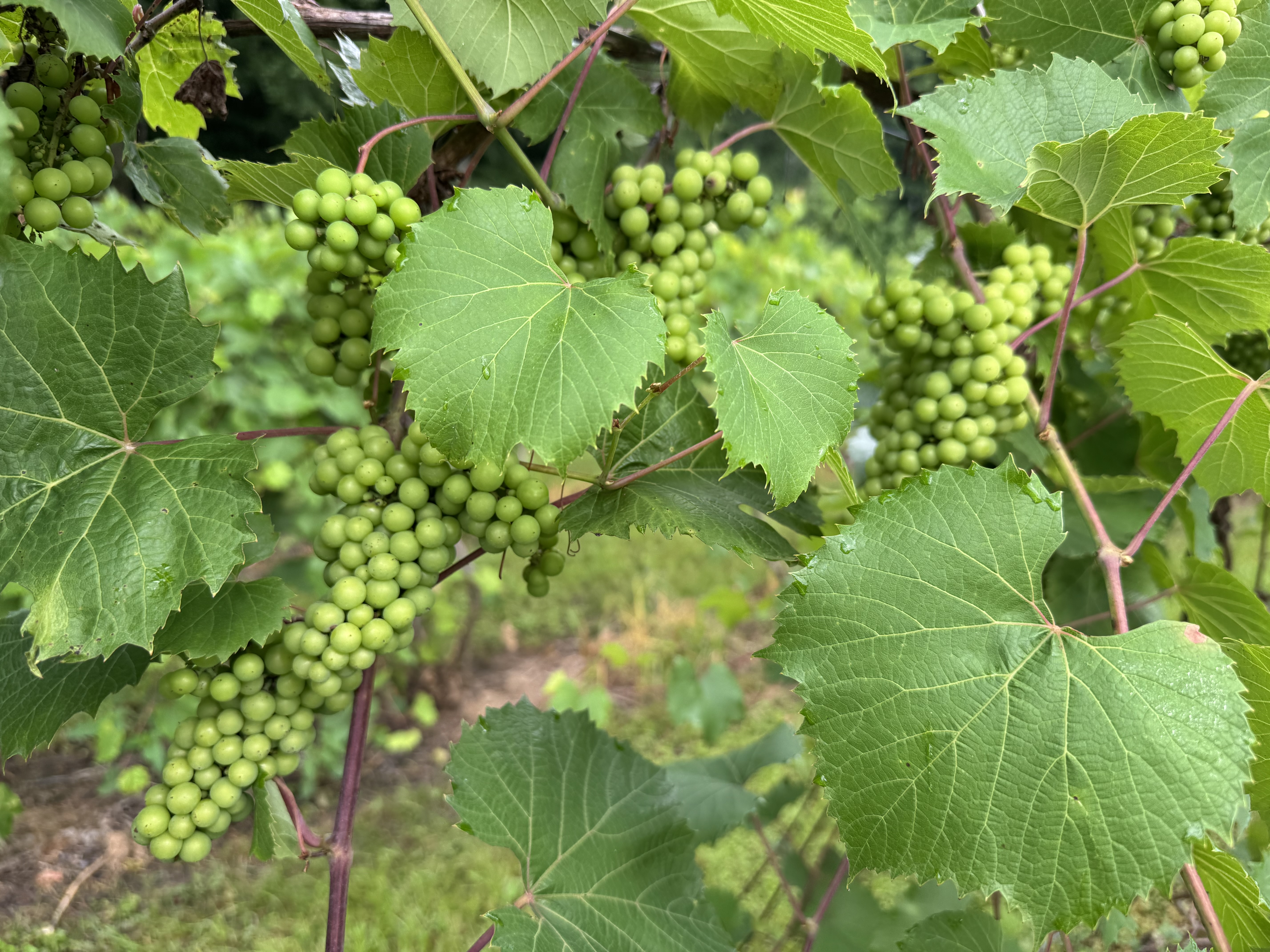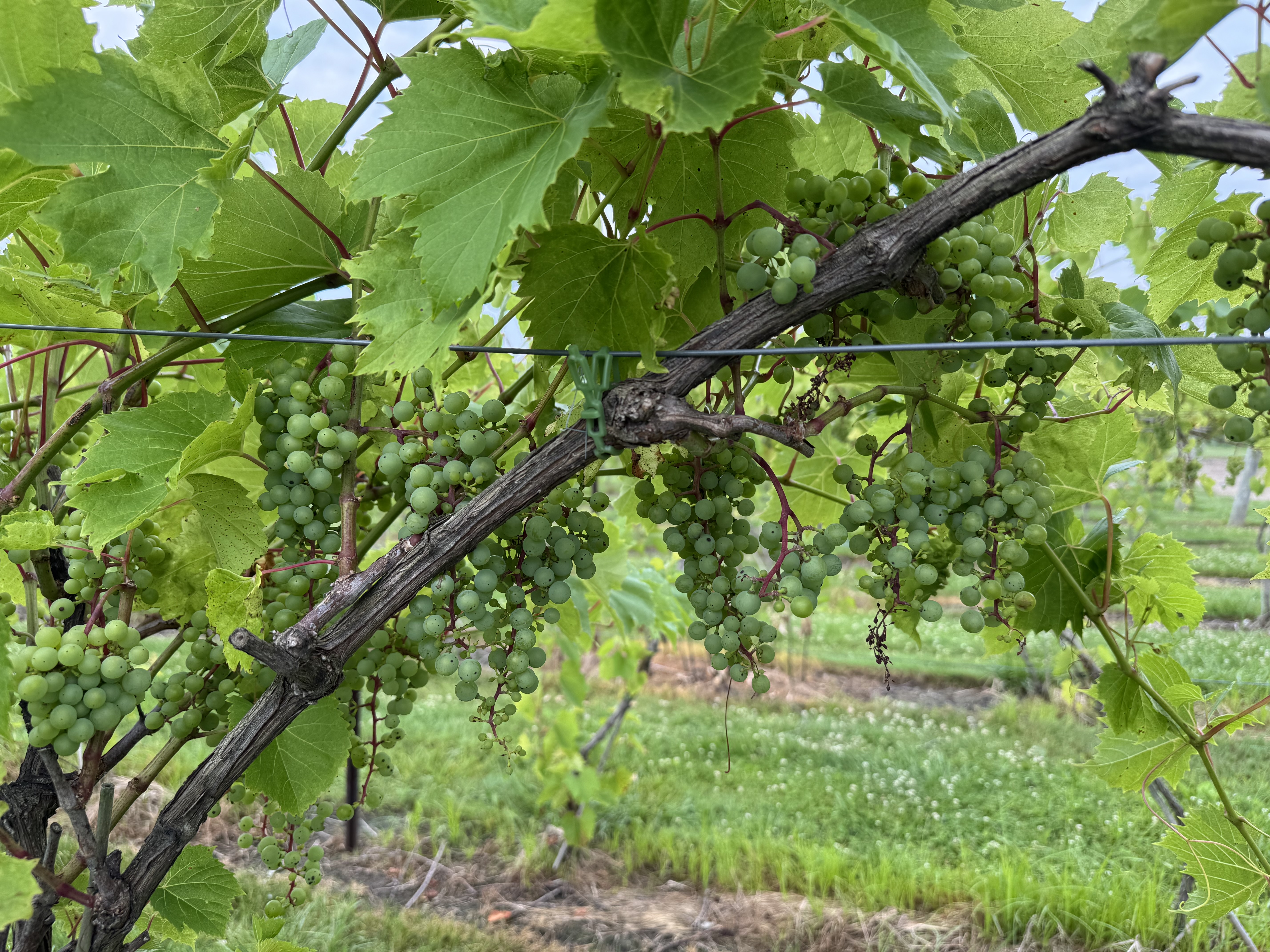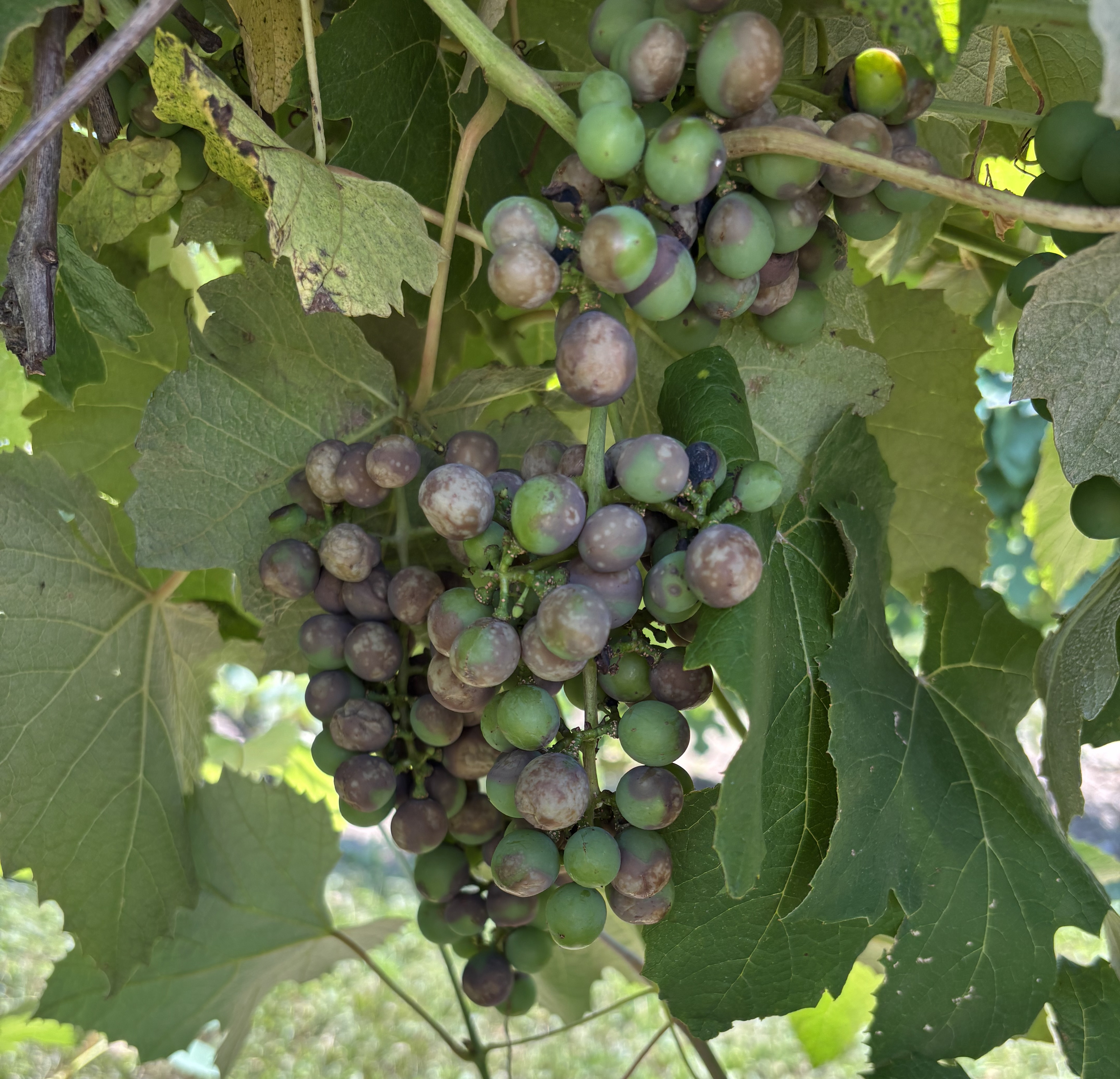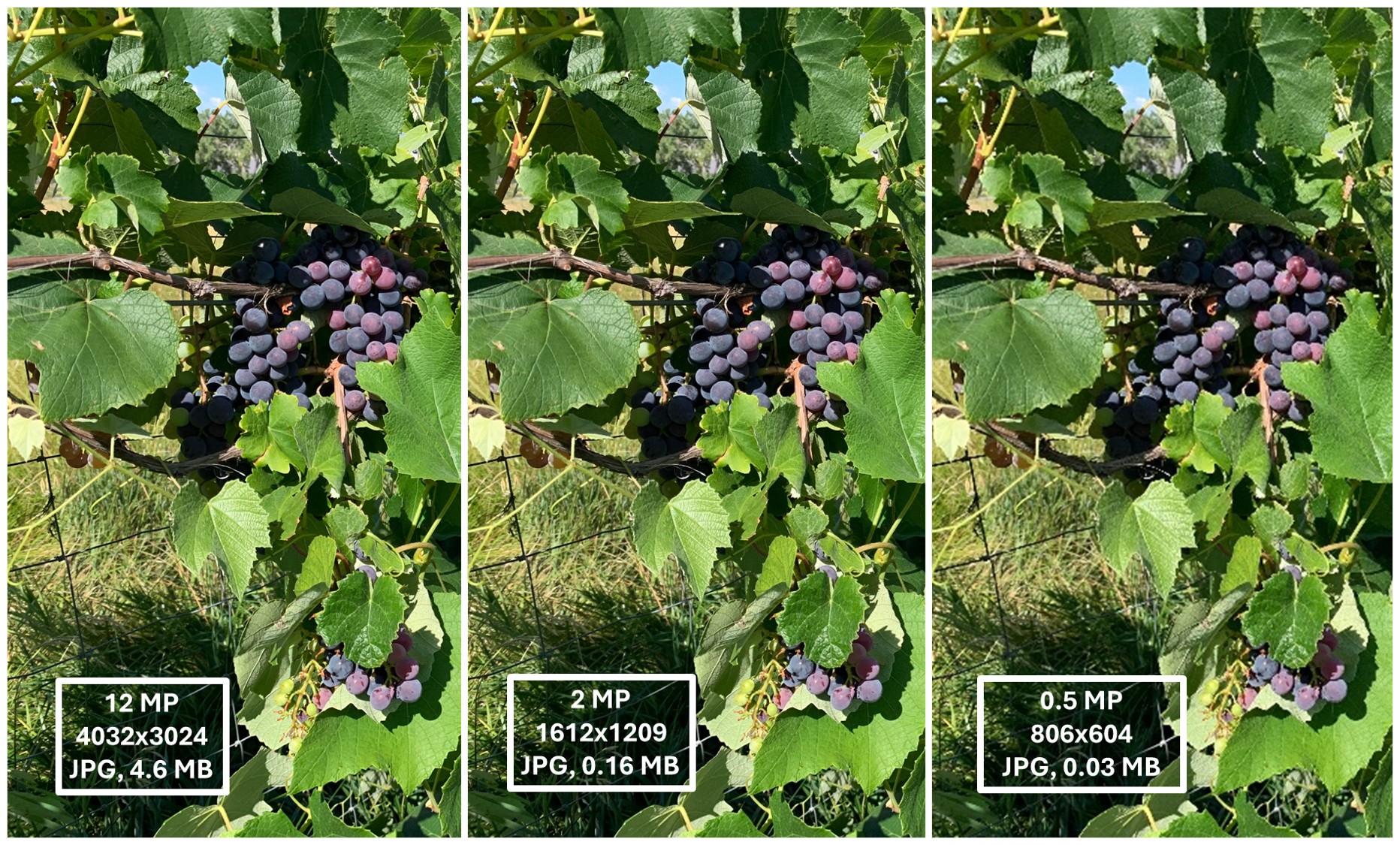Michigan grape scouting report – July 23, 2025
Check out the latest Michigan Grape Scouting Report for timely updates on weather, vine growth, disease management, and pest activity. Stay informed and make proactive decisions to support vineyard health and productivity.

Weather update
Detailed seven-day forecasts for Michigan grape production regions are available below:
- Southwest Michigan: Benton Harbor, Fennville, Lawton
- Southeast Michigan: Romeo
- Northwest Michigan: Old Mission, Petoskey, Traverse City
Agricultural Weather Outlook: Weekly in-season weather updates are provided to the Michigan State University Extension fruit team by Jeff Andresen, Michigan State University (MSU) agricultural meteorologist. These reports offer timely insights into weather conditions affecting fruit production across Michigan.
Growing degree day (GDD) report
Track vine development using the MSU Enviroweather Growing Degree Day (GDD) map. Visit the site to find your nearest weather station, create a free account, and monitor GDDs daily: MSU Enviroweather GDD Tool
Weekly GDD summary (Base 50 F)
The table below summarizes current GDD accumulation, last week's totals, and the weekly increase for each monitored location across Michigan:
|
Location |
Current GDD (Base 50 F) |
GDD Last Week |
Weekly Accumulation |
|---|---|---|---|
|
Benton Harbor (SWMREC) |
1674.1 |
1515.9 |
158.2 |
|
Fennville |
1518.8 |
1369.9 |
148.9 |
|
Lawton |
1650.3 |
1504.2 |
146.1 |
|
Average – Southwest Michigan |
1614.4 |
1463.3 |
151.1 |
|
Romeo |
1490.4 |
1365.0 |
125.4 |
|
Average – Southeast Michigan |
1490.4 |
1365.0 |
125.4 |
|
Old Mission |
1116.8 |
1006.3 |
110.5 |
|
Petoskey |
1076.9 |
974.7 |
102.2 |
|
Traverse City (NWMHRS) |
1210.7 |
1090.9 |
119.8 |
|
Average – Northwest Michigan |
1134.8 |
1024.0 |
110.8 |
Weather forecast
Last week was seasonable but dry. Southern Michigan experienced another week of highs in the mid-80s on most days. Northern Michigan was 5-10 degrees Fahrenheit cooler. Once again, high humidity kept the lows in the mid-60s in southern regions, and in the mid-50s to low 60s to the north, causing continued concern for powdery mildew infections.
Rain has been extremely variable. Last week, southwest and west central Michigan received less than a quarter inch of rain scattered across a couple of days. Southeast and northwest Michigan saw between 1 and 2 inches of rain on Friday and Saturday, July 18-19. This variability has been common this year. Southwest Michigan and other parts of the state have very dry soils. According to the U.S. Drought Monitor, some of the grape growing parts of the state are under drought conditions.
The forecast for the next week is for slightly warmer conditions in northern American Viticulture Areas (AVAs) and continued seasonable weather in southern locations. Most days should see high temperatures near 80 F in northwest Michigan, mid-80s further south. A cool front is predicted to bring some precipitation Thursday, July 24, with another system moving through over the weekend. Predictions are for less than an inch of rain for the northern AVAs, up to an inch in the rest of the state.
Vine growth
In southwest Michigan, most hybrids and juice grapes are at berry touch as are tight clustered vinifera cultivars. Leaf removal continues. The first round of cluster thinning is beginning. With concerns of harvest restrictions for juice grape growers, some Concord grapes are also being cluster thinned to improve quality at harvest.
In northern Michigan, shoot growth has accelerated rapidly over the past week. Most varieties are now at bloom or just past fruit set, corresponding to modified E-L phenology stages 30–32 (berries from pepper-corn size about 6 millimeters up to pea size about 8 millimeters). This confirms that fruit development is progressing well. For a precise visual reference, consult MSU Extension’s Grape Growth Stages chart.
In the Tip of the Mitt AVA, hybrid cultivars are at the berry touch stage and beginning bunch closure. Vitis vinifera cultivars are approaching the berry touch stage. Japanese beetle activity is increasing, and the risk of powdery and downy mildew is rising. Downy mildew has already been observed in some vineyards.
In southeast Michigan, fruit set looks good across the region, with most varieties nearing bunch closure. Grape berry moth trap counts remain low in Lenawee and Macomb counties.
Powdery mildew infection risk is high throughout the week of July 22-29. Conditions will support the spread of existing downy mildew, though new infections are not expected. Black rot risk remains low this week.


Horticulture
Accurate assessment of vineyard nutrient requirements is essential for optimizing vine health, fruit quality and yield. Implementing soil testing and petiole analysis provides critical data to inform nutrient management strategies. A quality soil test or a previous year’s petiole analysis is important in understanding which nutrients the vineyard needs.
Petiole analysis should be done at bloom and veraison, and at specific stages of vine development when nutrient concentrations in the petiole are most stable and representative of the vine's overall status. The most widely recommended timing for petiole sampling is at full bloom, which occurs when approximately 70% of the flowers on a cluster are open. This stage provides the most reliable data for key nutrients such as nitrogen, phosphorus, potassium and micronutrients.
An alternative or complementary sampling period is at veraison, when about half of the berries on a cluster begin to change color or soften. Sampling at veraison can be useful for monitoring nutrients like potassium, magnesium and boron later in the season or for tracking changes in nutrient dynamics over time.
Early hedging for healthier canopies and better ripening in cool climates
Early hedging, or cutting shoots shortly after they reach just above the top wire, can improve canopy efficiency and fruit ripening in cool-climate vineyards like those in northwest Michigan. Research from Michigan State University (MSU) shows that early hedging preserves younger, highly photosynthetically active leaves and promotes lateral growth, which supports ripening during late summer. It also reduces fruit zone shading and disease pressure while directing vine energy toward fruit development.
Timing is critical. Too early can cause overly dense canopies, especially in vigorous cultivars. When done correctly, early hedging improves canopy balance, fruit quality and ripening consistency in regions with short growing seasons.
Read more in the article “Early hedging for healthier canopies and better ripening in cool climates” from Michigan State University Extension.
Cluster zone leaf removal: Timing and technique
To regulate grape quality in cool-climate regions, growers employ various canopy management practices to counter the challenges of a short growing season. One of the most impactful techniques is cluster zone leaf removal, which plays a key role in reducing disease pressure and enhancing fruit quality.
This practice improves spray coverage and airflow around the fruit, lowering humidity and minimizing the risk of harvest season cluster rot complex, including Botrytis and sour rot. Increased sunlight exposure also encourages development of a thicker wax cuticle on the berry skin, providing natural resistance to fungal infections and enhancing grape quality.
Leaf removal can be performed manually or mechanically, and the industry is rapidly transitioning toward mechanization to improve both efficiency and economic sustainability. The effectiveness of this practice depends heavily on timing, particularly in relation to grapevine phenology.
Leaf removal is typically applied between fruit set and veraison to improve cluster zone microclimate and increase disease resistance. When implemented around bloom or shortly before, it can also reduce fruit set and result in looser clusters, a valuable outcome for tight-clustered cultivars like Pinot noir and Riesling, which are prone to rot due to berry compression.
Early leaf removal, at pre-bloom or pea-size stage, offers additional benefits under climate change conditions:
- Promotes flavonol synthesis, protecting berries from UV damage.
- Reduces incidence of cluster rot, potentially lowering fungicide use.
Mechanical early leaf removal systems (Collard leaf remover) use compressed air to remove leaves and dead flower tissue from the fruit zone. Removing dead ovaries is critical, as they serve as an entry point and nutrient base for Botrytis spores. The pathogen can remain latent until berry sugar levels rise and acidity drops, after which rot symptoms develop rapidly in warm, humid conditions.
Read more in the MSU Extension article, “Cutting to the core: Michigan State research leads a canopy innovation in cool-climate viticulture.”
Diseases
In southwest Michigan, disease management of downy mildew, powdery mildew and botrytis fruit rot are the primary focus. The morning dews we will begin to experience are an important reminder to maintain protection against downy mildew. With tight clustered varieties, this is the last chance to get botrytis bunch rot sprays into the tight crevices of the clusters.
In northwest Michigan, disease pressure is still low but continues to increase in specific areas where black rot is becoming more apparent. Black rot symptoms are beginning to show up throughout the state (Photo 4), but it is largely too late to control these infections and fruits will begin to become resistant.
In this growing stage, consider choosing fungicides that control all the foliar and fruit diseases. For example, with downy mildew we are most concerned with foliar infection, and sprays should be timed regularly throughout the season when we experience heavy dews for optimal control. Downy mildew is caused by a fungal-like organism, so many site-specific systemic fungicides that target other spring diseases do not work on downy mildew. Effective fungicides for downy mildew include products in FRAC codes 4, 11, 21, 40 and 45 as well as phosphorus acid salts and some biologically-based products.

If powdery mildew is the only concern, there are a number of effective products (FRAC codes 3, 7, 11, 13, U8, 50, and U13 as well as sulfur). Combining fungicides from different FRAC classes should also be effective while helping with resistance management.
As we approach bunch closure in southwest Michigan, consider botrytis management. Several strategies contribute to good botrytis bunch rot management including opening up the canopy, properly applying fungicides, and using resistant cultivars when possible. Good botrytis control depends on getting good coverage. Just before bunch closure is the last chance to apply a fungicide to the inner part of the developing cluster. Fungicide resistance management is also important. The most effective products for botrytis are site specific and prone to resistance development. A Michigan Grape Fact Sheet is available for managing botrytis bunch rot.
As you choose a fungicide, check the guide for potential phytotoxicity of certain sprays on Concord grapes especially (this has been particularly noted for fungicides like Revus Top). Phytotoxicity risk is higher with high temperatures and quickly growing vines. Also, there is a significant phytotoxicity risk with specific contact products such as copper and sulfur for Labrusca type grapes (Concord and Niagara).
Insects
Checks of grape clusters on Monday, July 21, in southwest Michigan showed that grape berry moth infestation levels vary by site, based on the local pressure and the effectiveness of recent control treatments. The grape berry moth larvae that were detected were mostly the largest stage, which will soon be pupating. The pupal stage lasts 10-14 days, so the third generation is expected to begin early August.
Continue to monitor clusters and the Enviroweather degree day model to determine timings for the third generation, which is when clusters in high risk vineyards should be protected. In areas already experiencing high grape berry moth pressure, a protective spray can reduce the survival of these larvae and limit the number of pupae that develop. A treatment just before bunch closure is important for getting coverage inside clusters—areas that become harder to spray in August— but the window for this application is closing in most southwest Michigan vineyards.
Northwest Michigan sites recently reached the timing for protecting clusters against grape berry moth (Table 1), reflecting the much later phenology in northern Michigan this summer.
Treatment for berry moth at this time of the season can overlap with the need for protection against Japanese beetle, foliar phylloxera and leafhoppers, all insects that have been observed during scouting in southwest Michigan. Check your own vineyards to determine the pest complex present at the sites.
As the canopy density increases, pesticide coverage becomes more of a challenge in vineyards. Increase gallonage, slow down and ensure the clusters are well covered for grape berry moth control. Using water-sensitive paper is a good approach to determine whether the inner canopy is getting a consistent density of droplets on the berries. The MSU Fruit Pest Management Guide (bulletin E154) has recommendations of efficacy against key insect pests. A hard copy or a PDF version can be ordered from shop.msu.edu.
Table 1. Recent timings of the second generation of grape berry moth, predicted by the MSU Enviroweather model.
|
Location |
Wild grape bloom biofix |
Predicted start of Gen 2 egglaying (810 GDD) |
Predicted start |
|
Berrien Springs (Berrien Co.) |
June 2 |
July 3 |
July 6 |
|
Lawton (Van Buren Co.) |
June 3 |
July 4 |
July 7 |
|
Fennville (Allegan) |
June 4 |
July 6 |
July 10 |
|
Deerfield (Lenawee) |
May 28 |
July 1 |
July 5 |
|
Romeo (Macomb Co.) |
May 30 |
July 5 |
July 8 |
|
NW Station (Leelanau) |
June 10 |
July 16 |
July 20 |
SAM Tool
Scouting function upgraded — bigger photo uploads now supported
The Sustainable Agricultural Management (SAM) Tool 's scouting function has been upgraded to better support scouting needs. Users can now upload photos up to 16 MB in size, a major increase from the previous 2 MB limit. This update significantly reduces the likelihood of encountering frustrating “file too large” errors—especially helpful when using newer smartphones that produce high-quality images.
While the file size of a photo depends on resolution, compression and content, most everyday smartphone cameras capture photos in the 12-16 megapixel (MP) range. These typically result in JPG files between 4-6 MB—well below the new 16 MB limit. Even 24 MP photos may now fit within the updated limit.
To illustrate the difference: The composite image below shows how much visual clarity is retained even when a 12 MP photo is resized down to 2 MP and 0.5 MP. At typical scouting scales, differences may appear minimal to the naked eye. However, when scouting for insects, diseases, or subtle damage, full-resolution images (12 MP or higher) may be valuable for accurate records or future diagnosis.

In rare cases, some smartphones may capture photos larger than 24 MP. If this causes upload issues, resizing the image or adjusting camera settings (e.g., to “medium” photo quality) should resolve the upload problem.
For new users: Explore more functions at the web app and download the mobile app
In addition to scouting, the SAM Tool helps manage vineyard activities such as assigning tasks, tracking restricted-entry intervals, maintaining farm calendars, and keeping searchable records.
- Android: SAM Tool on Google Play
- iPhones: SAM Tool on the App Store
- Web browser: Visit sustainableag.msu.edu
Once workers or collaborators have signed up, farm managers can add them to the digital workforce using the “Add User” feature on the SAM Tool website. If you have suggestions or would like help getting started, please contact us at sustainableag@msu.edu or reach out to Karen Chou, PhD, directly at chouk@msu.edu. We’d be happy to show you how SAM Tool can support your vineyard’s recordkeeping, compliance and research efforts.
Need help or have ideas for improvement?
We’re here to help—and we also need your help. The SAM Tool is being developed through the shared knowledge, feedback and dedication of many growers and MSU researchers. Your input is essential to shaping a tool that truly serves the needs of Michigan vineyards. If you have questions, want help getting started, or have suggestions for improvement, please contact us at sustainableag@msu.edu or reach out to Karen Chou directly at chouk@msu.edu. Let’s keep building the SAM Tool together!
Party on the Piazza: Volunteers needed plus Georgian wine tasting

Join us for an evening of community, connection and celebration at Party on the Piazza on Thursday, Aug. 21, from 5-9:30 p.m. at the Grand Traverse Commons.
This relaxed, festive gathering brings together friends and colleagues from across Michigan’s wine and grape industry. One of the evening’s highlights will be a Georgian wine tasting led by Nino Sachaleli, PhD, a visiting expert from the Republic of Georgia. She’ll be sharing wines and stories from one of the world’s oldest winemaking traditions.
We’re also looking for volunteers to help make this event a success, whether it's setting up, pouring wine or helping with coordination. If you're interested in being part of the team, fill out the volunteer registration form by July 30.
You're also invited to bring a bottle of your own wine to share. Let’s make this a memorable celebration of wine, culture and connection. Raise a glass and celebrate the season together!
Upcoming events
The 36th annual Michigan Viticulture Field Day and 2nd annual Michigan Enology Experience

Michigan State University’s famous Viticulture Field Day on July 30 is a staple for the state’s grape growing community. The latest local viticulture research will be showcased. New last year for the winemakers, MSU partnered with Lake Michigan College to add a second day for wine making education. The Michigan Enology Experience on July 31 provides hands-on education for new and established enologists alike. View more information and registration details.
2025 Dirt to Glass Conference: Elevating Michigan Wine from the Ground Up
Join grape growers, winemakers, researchers and industry leaders Aug. 21-22 in Traverse City, Michigan, for two days of insight, collaboration and innovation. From site selection to sustainable practices and wine marketing, this event is designed to strengthen Michigan’s wine industry—one vine and one voice at a time. Register now and be part of the movement from intention to impact.
Follow us on Facebook and Instagram for the latest industry news, educational programs and viticulture resources. Stay connected and informed with timely updates and expert insights.
Related articles
- Early hedging for healthier canopies and better ripening in cool climates
- Rose chafer management for northwest vineyards
- Fruit insecticide registration update for 2023
- Southwest Michigan fruit update – June 4, 2024
- Michigan grape scouting report – June 15, 2022
- MSU Fruit Pest Management Guide (E-154)
- Grape growth stages
- Early season vineyard disease management
- Early season vineyard management
- A Mobile Guide for Grape IPM Scouting in North Central and Eastern U.S.
- Using the MSU Enviroweather grape berry moth model in 2018



 Print
Print Email
Email